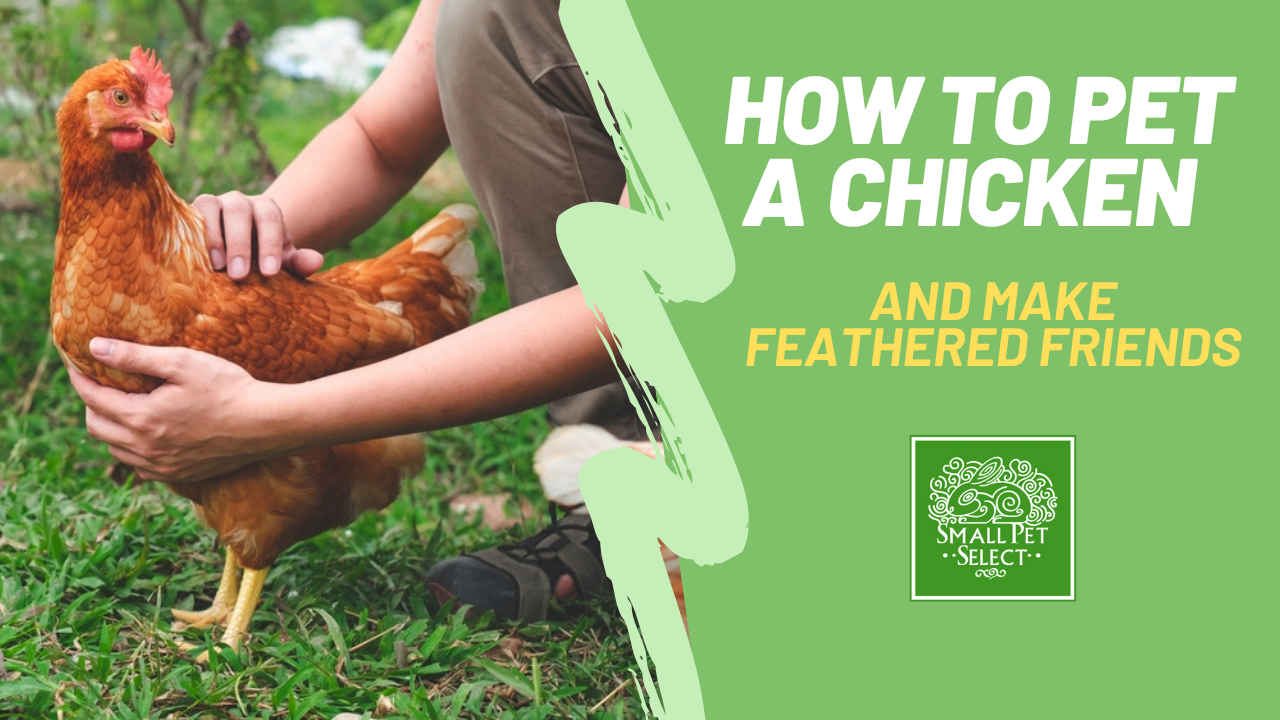Petting a chicken may seem unusual, but many enjoy it. Chickens can be friendly and affectionate pets.
Chickens, often seen as barnyard animals, can be surprisingly endearing. They enjoy human interaction and can form bonds with their owners. Knowing how to properly pet a chicken ensures both you and the bird have a positive experience. This guide will help you understand the basics of petting a chicken.
You’ll learn about their comfort zones and the best techniques to use. Whether you’re a new chicken owner or just curious, this post will offer useful insights. Get ready to discover how delightful and rewarding it can be to pet a chicken.
Choosing The Right Chicken
Choosing the right chicken is important for a great pet experience. Not every chicken breed or age suits every owner. Some chickens are friendly and calm. Others can be more spirited. Knowing what to look for can help you find the perfect feathered friend.
Breeds To Consider
There are many chicken breeds to choose from. Some popular ones for pets include Silkies, Buff Orpingtons, and Cochins. Silkies are known for their fluffy feathers and gentle nature. Buff Orpingtons are friendly and good with children. Cochins are calm and easy to handle. Each breed has its own unique traits.
Age And Temperament
Age affects a chicken’s behavior and how easy they are to train. Young chicks can be more adaptable. They can get used to being handled more easily. Older chickens might be more set in their ways. Temperament also plays a role. Calm chickens are easier for beginners. They are less likely to peck or scratch.

Credit: www.wikihow.com
Setting Up A Comfortable Coop
Setting up a comfortable coop for your chickens is essential for their well-being. A well-designed coop provides shelter, safety, and comfort. It ensures your chickens remain healthy and happy. Let’s explore how to set up a cozy coop.
Space Requirements
Chickens need enough space to move freely. A crowded coop can cause stress and health issues. Aim for at least 4 square feet per chicken inside the coop. For the outdoor run, provide 10 square feet per chicken. This allows them to stretch, forage, and exercise.
Nesting And Roosting
Proper nesting and roosting areas are crucial. Chickens lay eggs in nesting boxes. Ensure you have one nesting box for every 3-4 hens. Line the boxes with straw or shavings for comfort. Place them in a quiet, dark corner of the coop.
Chickens also need roosting bars to sleep. Provide 8-10 inches of roosting space per chicken. Use smooth, rounded bars to prevent foot injuries. Position the roosting bars higher than the nesting boxes. Chickens prefer to roost off the ground.
Feeding Your Chicken
Feeding your chicken properly ensures they stay healthy and happy. Chickens need a balanced diet to lay eggs and grow strong. A good diet includes grains, vegetables, and proteins. Avoid giving them processed foods or too many treats.
Balanced Diet
A balanced diet is crucial for your chicken’s health. Provide a mix of grains like corn and wheat. Fresh vegetables like lettuce and carrots are great. Protein sources such as mealworms help them grow. Ensure fresh, clean water is always available. This keeps them hydrated and supports digestion.
Treats And Supplements
Chickens love treats, but give them in moderation. Fruits like berries and apples are safe. Avoid sugary or salty snacks. Supplements can also help. Grit aids digestion, and calcium supports egg production. Offer these to keep your chickens in top shape.
:strip_icc()/pet-chickens-1238426-hero-2a094e97ae024859a044b0065e9be86d.jpg)
Credit: www.thesprucepets.com
Handling Your Chicken
Successfully handling your chicken ensures it stays calm and happy. Proper techniques keep both you and the chicken safe. Read on to learn the best ways to handle your feathered friend.
Approaching Your Hen
Approach the hen slowly and quietly. Sudden movements can scare them. Speak softly as you get closer. This soothes the chicken.
- Move slowly
- Speak softly
- Avoid sudden movements
Extend your hand gently. Let the hen see and smell you. This builds trust.
Holding Techniques
Once close, you can pick up your chicken. Use both hands to support its body. Place one hand under its belly. Use the other hand to support its feet.
- Support the body with one hand
- Hold the feet with the other hand
Gently press the chicken against your body. This makes it feel secure. Avoid squeezing too hard. Always be gentle.
For longer holds, sit down and place the chicken on your lap. This relaxes the hen. It also allows you to pet it easily.
Remember, practice makes perfect. The more you handle your chicken, the more comfortable it will be.
Health And Wellness
Chickens, like all pets, need proper care to stay healthy. Understanding their health and wellness is key. This ensures they live a happy and productive life. Petting a chicken involves more than just physical touch. It also includes monitoring their health.
Common Ailments
Chickens can suffer from various ailments. These include respiratory issues, mites, and lice. Respiratory problems can cause coughing and sneezing. Mites and lice can make them itchy and uncomfortable. Regularly checking your chickens helps spot these issues early. Early detection can prevent severe problems.
Preventative Care
Preventative care is essential for your chicken’s health. Ensure their living area is clean and dry. Clean bedding regularly to avoid buildup of waste. Provide a balanced diet to support their immune system. Vaccinations can also protect against common diseases. Regularly inspect your chickens for signs of illness.
Keep an eye on their behavior and appearance. Healthy chickens are active and alert. Their feathers should be smooth and shiny. If you notice any changes, consult a vet. Preventative care helps keep your chickens happy and healthy.
Socializing Your Chicken
Socializing your chicken is crucial for their well-being and happiness. A well-socialized chicken will be friendlier, healthier, and more productive. Here are some tips to help you socialize your chicken effectively.
Interaction With Other Hens
Chickens are social animals and thrive in groups. Introducing your chicken to other hens is important for their social development.
- Start with supervised interactions. Allow them to meet in a neutral area.
- Observe their behavior. Look for signs of aggression or stress.
- Provide plenty of space. Crowded conditions can lead to fights.
Gradually increase the time they spend together. This helps them form a pecking order without causing harm.
Introducing To New Environments
Chickens need to explore different environments to stay stimulated. Introducing your chicken to new environments helps them adapt and reduces stress.
- Start with small changes. Introduce new objects or toys in their coop.
- Allow them to explore at their own pace. Avoid forcing them.
- Provide a safe space. Ensure the new environment is secure and free of predators.
Gradual exposure to new environments builds their confidence. It also helps them become more adaptable.
| Environment | Duration | Notes |
|---|---|---|
| Coop | Daily | Ensure it’s clean and safe. |
| Yard | Several hours | Supervise their outdoor time. |
| New areas | Gradually | Introduce slowly and watch for stress. |
Remember, socializing your chicken takes time and patience. With consistent effort, your chicken will be happy and well-adjusted.
Grooming Your Chicken
Chickens need regular grooming to stay healthy and happy. Grooming your chicken includes taking care of their feathers and keeping them clean. Let’s dive into some tips and tricks to ensure your feathered friend looks its best.
Feather Care
Feather care is essential for your chicken’s well-being. Clean feathers help regulate body temperature and protect against infections.
- Inspect Feathers Regularly: Check for broken or missing feathers. Replace them if necessary.
- Dust Baths: Provide a dust bath area. Dust helps remove parasites and keeps feathers clean.
- Feather Trimming: Occasionally, trim feathers around the vent area. This prevents dirt and droppings from sticking.
Bathing Tips
Bathing a chicken is sometimes necessary. Follow these tips to make the process smooth.
- Warm Water: Use warm water, not hot. Fill a basin enough to submerge the chicken up to its body.
- Mild Soap: Use a mild soap or baby shampoo. Avoid harsh chemicals that can irritate the skin.
- Gently Wash: Hold the chicken securely. Gently wash the feathers, especially around the dirty areas.
- Rinse Thoroughly: Ensure all soap is rinsed off. Residual soap can cause skin irritation.
- Dry Completely: Pat the chicken dry with a towel. Use a hairdryer on a low setting if necessary.
Regular grooming keeps your chicken healthy and happy. It also strengthens the bond between you and your pet. Happy grooming!
Behavioral Insights
Understanding how to pet a chicken involves knowing their behavior. Chickens are complex creatures with their own unique behaviors. Recognizing these behaviors helps you interact with them safely and effectively. This section delves into understanding their behavior and identifying signs of stress.
Understanding Chicken Behavior
Chickens communicate through body language and vocalizations. They use these methods to express various emotions and needs. Learning to read these cues is essential for successful interaction.
- Pecking Order: Chickens have a social hierarchy known as the pecking order. This determines their place within the flock. Respect this structure to avoid causing stress.
- Vocalizations: Chickens make different sounds for different reasons. Clucking often means they are content, while squawking may indicate discomfort or alarm.
- Body Language: Watch their posture and movements. Relaxed chickens will have smooth feathers and a calm demeanor. Aggressive or scared chickens may puff up their feathers or make quick movements.
Signs Of Stress
Recognizing signs of stress in chickens helps you ensure their well-being. Stress can lead to health problems and behavioral issues.
- Feather Pecking: Excessive pecking or loss of feathers can indicate stress. It may be due to overcrowding or lack of resources.
- Reduced Egg Production: Stressed hens may lay fewer eggs. This can be a sign of underlying stress factors.
- Changes in Eating Habits: Chickens may eat less or more than usual. Sudden changes in diet can signal stress.
- Increased Aggression: Aggressive behavior towards other chickens or humans often indicates stress. This is especially true in tightly confined spaces.
By understanding these behavioral insights, you can create a safe and comfortable environment for your chickens. This knowledge also makes petting and handling them a positive experience for both you and your feathered friends.

Credit: smallpetselect.com
Frequently Asked Questions
How Do You Pet A Chicken Properly?
To pet a chicken properly, approach calmly and gently stroke its back. Avoid sudden movements. Always be gentle.
Where Do Chickens Like To Be Petted?
Chickens typically enjoy being petted on their back and under their wings. They also like gentle strokes on their necks.
Can Petting A Chicken Calm It?
Yes, petting a chicken can calm it. Gentle strokes can make chickens feel safe and relaxed.
What Should You Avoid When Petting Chickens?
Avoid petting chickens on their head or tail. Do not use sudden movements. Be gentle and calm.
Conclusion
Petting a chicken can be a rewarding experience. Remember to approach gently. Start with soft strokes on their back. Keep an eye on their body language. Chickens appreciate calm and steady movements. With patience, you build trust. Over time, your chicken will enjoy these moments.
Enjoy bonding with your feathered friend. Happy petting!




